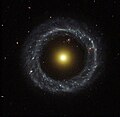File:Hoag's object.jpg
外观

本预览的尺寸:612 × 599像素。 其他分辨率:245 × 240像素 | 490 × 480像素 | 785 × 768像素 | 1,046 × 1,024像素 | 1,521 × 1,489像素。
原始文件 (1,521 × 1,489像素,文件大小:934 KB,MIME类型:image/jpeg)
文件历史
点击某个日期/时间查看对应时刻的文件。
| 日期/时间 | 缩略图 | 大小 | 用户 | 备注 | |
|---|---|---|---|---|---|
| 当前 | 2019年4月18日 (四) 17:22 |  | 1,521 × 1,489(934 KB) | FriedrichKieferer | Better quality. |
| 2007年1月2日 (二) 13:17 |  | 1,521 × 1,489(401 KB) | Kalki | ||
| 2006年3月3日 (五) 19:37 |  | 350 × 343(9 KB) | Centaurus~commonswiki | Category:Galaxies |
文件用途
全域文件用途
以下其他wiki使用此文件:
- af.wikipedia.org上的用途
- ar.wikipedia.org上的用途
- arz.wikipedia.org上的用途
- LEDA 41149 (مجره)
- LEDA 2052159 (مجره)
- LEDA 83319 (مجره)
- LEDA 41917 (مجره)
- ESO 499 37 (مجره)
- SDSS J084337.97+402547.1 (مجره)
- UGC 4527 (مجره)
- UGC 8839 (مجره)
- ان جى سى 4369 (مجره)
- ان جى سى 7456 (مجره)
- ان جى سى 4366 (مجره)
- NGC 4636 (مجره)
- NGC 3423 (مجره)
- NGC 3666 (مجره)
- IC 3530 (مجره)
- IC 3328 (مجره)
- IC 2004 (مجره)
- IC 1218 (مجره)
- NGC 4336 (مجره)
- NGC 4459 (مجره)
- NGC 4464 (مجره)
- NGC 4544 (مجره)
- ان جى سى 4654 (مجره)
- NGC 4700 (مجره)
- NGC 4941 (مجره)
- NGC 4984 (مجره)
- NGC 5103 (مجره)
- NGC 7250 (مجره)
- NGC 7361 (مجره)
- NGC 3443 (مجره)
- NGC 3447 (مجره)
- NGC 3457 (مجره)
- NGC 3757 (مجره)
- NGC 3955 (مجره)
- ان جى سى 4203 (مجره)
- UGC 191 (مجره)
- AGC 233681 (مجره)
- SDSS J122928.18+203348.7 (مجره)
- UGC 5459 (مجره)
- UGC 12340 (مجره)
- SDSS J112152.80+032421.2 (مجره)
- LEDA 1230703 (مجره)
查看此文件的更多全域用途。


